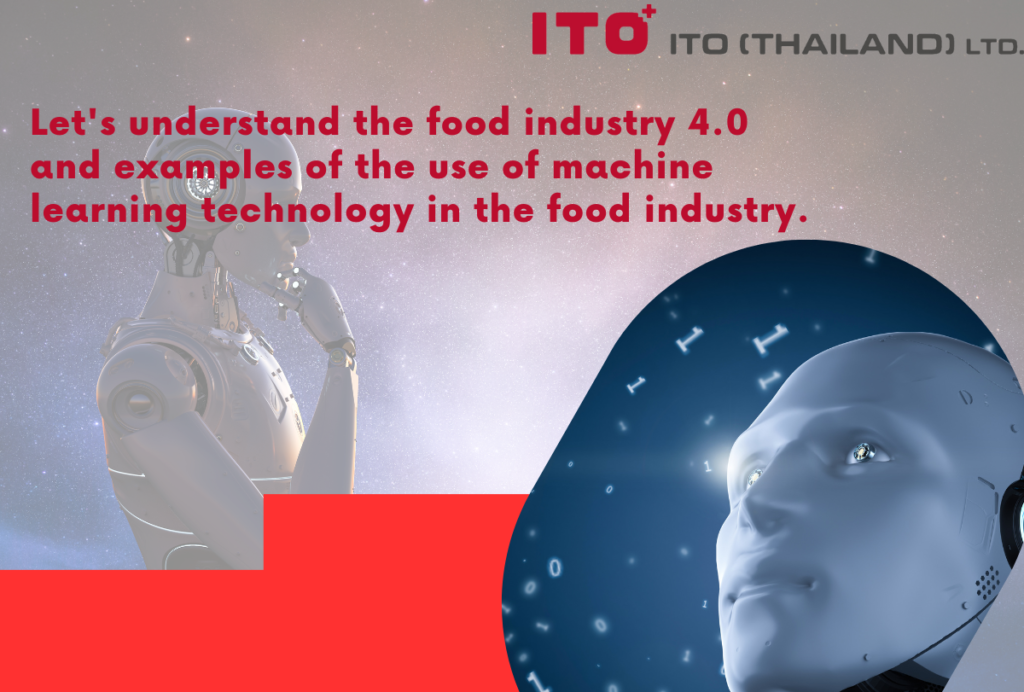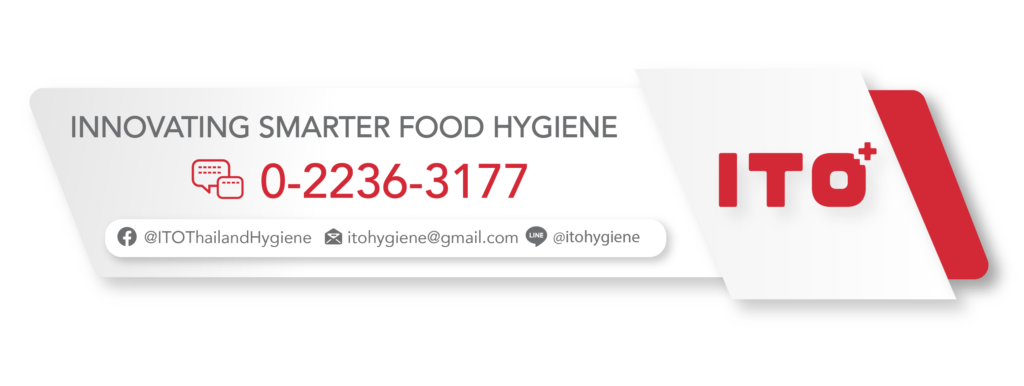ITO Thailand Hygiene Blog
Food industry 4.0: Machine learning for new era of food safety
Food industry 4.0: Machine learning for new era of food safety
Let’s understand the food industry 4.0 and examples of the use of machine learning technology in the food industry.
What is food industry 4.0?
At present, various challenges such as new epidemics, food waste, global warming, population growth, combined with the growth of new technologies, have prompted the emergence of the industrial revolution as Industry 4.0, just as the food industry has been affected and needs to adapt as well. Industry 4.0 is an era in which advanced technologies such as AI, IoT, blockchain, robotics, automation, data analytics are applied to assist in the food industry. Such application is to make food available in a greater quantity with better quality, to reduce issues of safety and waste in the food industry, decrease environmental impact, and being more sustainable as well. Thus, we are in an age where the traditional production and food industry are transitioning into a very different new era.
This change in the industry has forced governments to develop action plans that are aligned with new technologies and consumer behaviors. For instance, the United States Food and Drug Administration (USFDA) has devised the New Era of Smarter Food Safety Blueprint.
What is Machine Learning?
Machine learning (ML) is a subset of artificial intelligence (AI) focusing on developing algorithms by allowing the system to learn from input data and practice to increase the work efficiency: an image input is made, and the ML practices distinguishing objects in pictures and improves until it can clearly tell apart the desired image from the image that is not, etc.
Application of Machine Learning in the food industry
Currently, there are many academic studies that attempt to apply machine learning in the food industry. But one very important application is in the effort to make food safer, easier to examine, require less time spent for food safety analysis or making decisions to protect consumer safety (e.g., market recalls). In addition, food quality and safety predictions can be made possible with samples that do not ruin food (such as images, frequency analysis, source data, temperature, volatile substances, environmental data from various sensors). Therefore, in this article, we will share some interesting examples of machine learning studies on food safety.
Wang et al. (2021) (1) divided machine learning applications for food safety into 3 types: hazard detection, contaminated food detection, and food traceability.
•Food hazard detection
A food hazard analysis can be a biological, chemical, or physical.
For biological hazards, the detection may be the isolation of microorganisms or insects, source analysis, prediction of microbial growth and control in food. For example, a 2020 (2) study reports the development of machine learning to predict the origination of Salmonellosis (foodborne disease caused by Salmonella) in Denmark. Microbial genomes sampled from humans, food and animals were analyzed to predict the source of the disease in humans. Or a research study to predict the quality of microorganisms in edible algae (3) from sensor data input, image analysis, and Spectroscopy.
The detection of chemical hazards may focus on toxins in food, pesticides, heavy metals, or food impurities. For example, research has predicted the risk of mycotoxin contamination of aflatoxin B1 in animal feed by inputting information about animal feed (4) such as type, period, country, etc. Or research using machine learning to learn input from hyperspectral imaging to predict mycotoxin contamination in corn kernels without destroying the feed sample (5).
Physical hazards may be detected by learning the abnormal nature of the product or contaminants such as scraps of container, dust, metal, plastic, wood, etc. The system learns microwave imaging (low frequency microwave that characterize the sample without damaging it) showing impurity contamination in hazelnut butter jars (6) to separate contaminated products in real time.
In addition to direct hazard analysis, the system could be used to learn human behaviors for good manufacturing hygiene, such as learning to assess handwashing hygiene standards by using a camera and AI analysis (watch the video).
•Food fraud detection
In addition to contamination detection, machine learning could also be used to detect food fraud. It may be used for quality analysis (e.g., tomato ripeness grading using a robotic tapping system (7)) or for food adulteration, e.g., volatile matter graph analysis using gas chromatography to detect adulteration in sesame oil with vegetable oil (8), or analysis of syrup contamination in fruit juice from data measured by sensors (9), for example.
•Food traceability
In the food production chain, from the production of raw materials to the consumers, there are many journeys of each ingredient that account for a vast amount of data. This data can be used to train the system to learn to monitor and trace back to the source. For the machine learning part, it can be one of the helpers, such as learning to analyze the movement of RFID tags (10) to increase product tracking efficiency, etc.
If you are interested in organizational development in line with Industry 4.0 or want to learn new technologies for safety in food products, you can contact us to request or make an appointment to consult the development of your standards or technology immediately.
References
1.Wang, X., Bouzembrak, Y., Lansink, A. O., & van der Fels‐Klerx, H. J. (2022). Application of machine learning to the monitoring and prediction of food safety: A review. Comprehensive Reviews in Food Science and Food Safety, 21(1), 416-434.
2.Munck, N., Njage, P. M. K., Leekitcharoenphon, P., Litrup, E., & Hald, T. (2020). Application of whole‐genome sequences and machine learning in source attribution of Salmonella Typhimurium. Risk Analysis, 40(9), 1693-1705.
3.Lytou, A. E., Tsakanikas, P., Lymperi, D., & Nychas, G. J. E. (2022). Rapid Assessment of Microbial Quality in Edible Seaweeds Using Sensor Techniques Based on Spectroscopy, Imaging Analysis and Sensors Mimicking Human Senses. Sensors, 22(18), 7018.
4.Wang, X., Bouzembrak, Y., Oude Lansink, A. G. J. M., & Van der Fels-Klerx, H. J. (2022). Designing a monitoring program for aflatoxin B1 in feed products using machine learning. npj Science of Food, 6(1), 40.
5.Chakraborty, S. K., Mahanti, N. K., Mansuri, S. M., Tripathi, M. K., Kotwaliwale, N., & Jayas, D. S. (2021). Non-destructive classification and prediction of aflatoxin-B1 concentration in maize kernels using Vis–NIR (400–1000 nm) hyperspectral imaging. Journal of Food Science and Technology, 58, 437-450.
6.Casu, M. R. (2019). Detection of food contaminants with Microwave Sensing and Machine Learning(Doctoral dissertation, Politecnico di Torino).
7.Bandyopadhyaya, I., Babu, D., Bhattacharjee, S., & Roychowdhury, J. (2014). Vegetable grading using tactile sensing and machine learning. In Advanced Computing, Networking and Informatics-Volume 1: Advanced Computing and Informatics Proceedings of the Second International Conference on Advanced Computing, Networking and Informatics (ICACNI-2014)(pp. 77-85). Springer International Publishing.
8.Peng, D., Bi, Y., Ren, X., Yang, G., Sun, S., & Wang, X. (2015). Detection and quantification of adulteration of sesame oils with vegetable oils using gas chromatography and multivariate data analysis. Food Chemistry, 188, 415-421.
9.Naskar, H., Nandeshwar, V., & Das, S. (2018, December). Adulteration detection of grape fruit juice using PCA and LDA pattern recognition technique. In 2018 IEEE Applied Signal Processing Conference (ASPCON)(pp. 83-86). IEEE.
10.Alfian, G., Syafrudin, M., Farooq, U., Ma’arif, M. R., Syaekhoni, M. A., Fitriyani, N. L., … & Rhee, J. (2020). Improving efficiency of RFID-based traceability system for perishable food by utilizing IoT sensors and machine learning model. Food Control, 110, 107016.
Related Post
-

Biodegradable Packaging
As straightforward as its name, it means any packaging that will naturally fall apart and decompose. In recent years, biodegradable packaging has been included as one of the sustainable development goals for several organisations. A similar issue, bioplastics, an alternative to sustainable living, was discussed in a previous blog. However, there are some differences between them. For example, bioplastics are made from raw materials sourced from renewable and natural sources and could or could not be biodegradable. In contrast, biodegradable plastic can naturally degrade through living organisms no matter the source material it originates from. The development history of biodegradable packaging, frequently used materials, the pros and cons of biodegradable packaging, and its future trends will be discussed in this blog.
-

Precision Agriculture
Precision agriculture has revolutionised how we approach crop management by optimising the inputs to meet specific requirements. Even though it is not a new system, recent technologies have made it possible to apply it in practical productions. In this blog, we will discuss the definition of precision agriculture, its pros and cons, and future trends.
-

Vertical Farming
Agriculture has utilised nearly all the available land, causing growing difficulty in finding land on the earth’s surface. With limited resources, meeting the world’s food demands will require more innovative and dependable methods of producing safe food, and the answer lies in vertical farming.
-
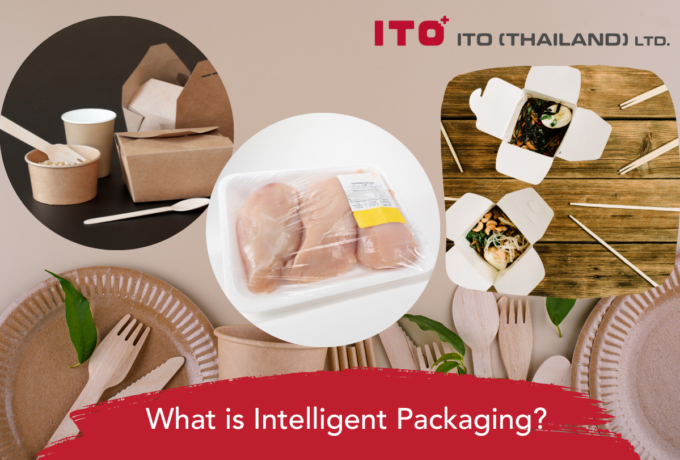
Intelligent Packaging
Without packaging, food products would last for only a short period of time, impossible for logistics management, difficulties in the supply chain system, quick quality deterioration, and prone to contamination to risky foodborne pathogens. In reality, there are many more functions that packaging is contributing to food products, as well as many types of smart packaging. Intelligent packaging is considered to be a part of smart packaging, so in this blog, we will discuss the contribution of intelligent packaging to food products.
-
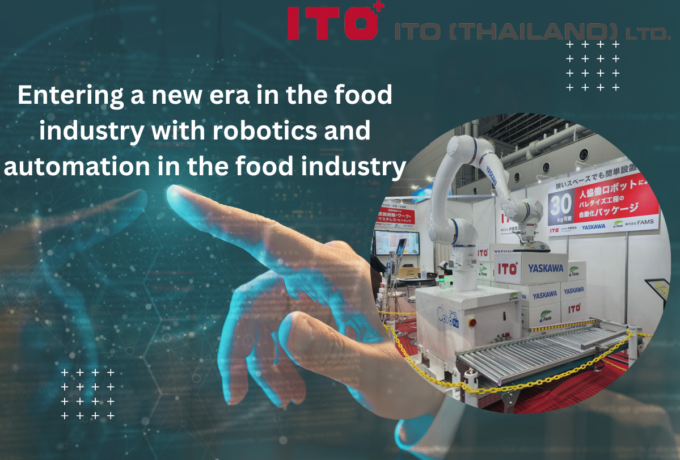
Robots & automation in the food industry
Entering a new era in the food industry with robotics and automation in the food industry
-
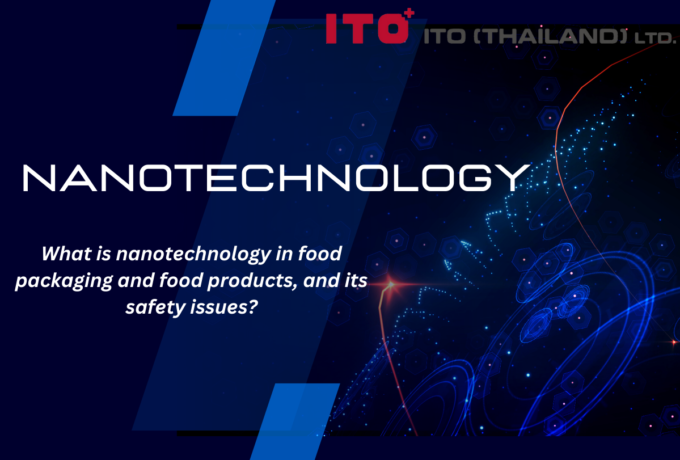
Nanotechnology in the Food Industry
Nanotechnology has been brought to our attention for the last decades, and it has provided various beneficial applications to the food industry. Unlike other technology, nanotechnology has broadened the knowledge in the food industry to another level in a nanoscale dimension. It involves almost every aspect of the food industry, including food packaging, food processing, as well as functional food development and enhancement of food safety. In this blog, we will discuss how nanotechnology is used in food packaging and food products, and the most important part, its safety issues.








